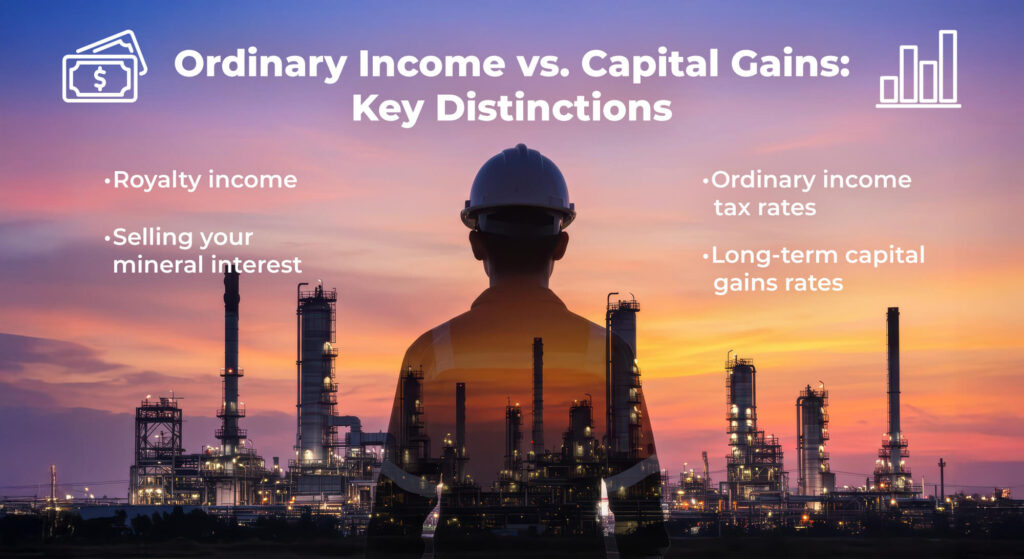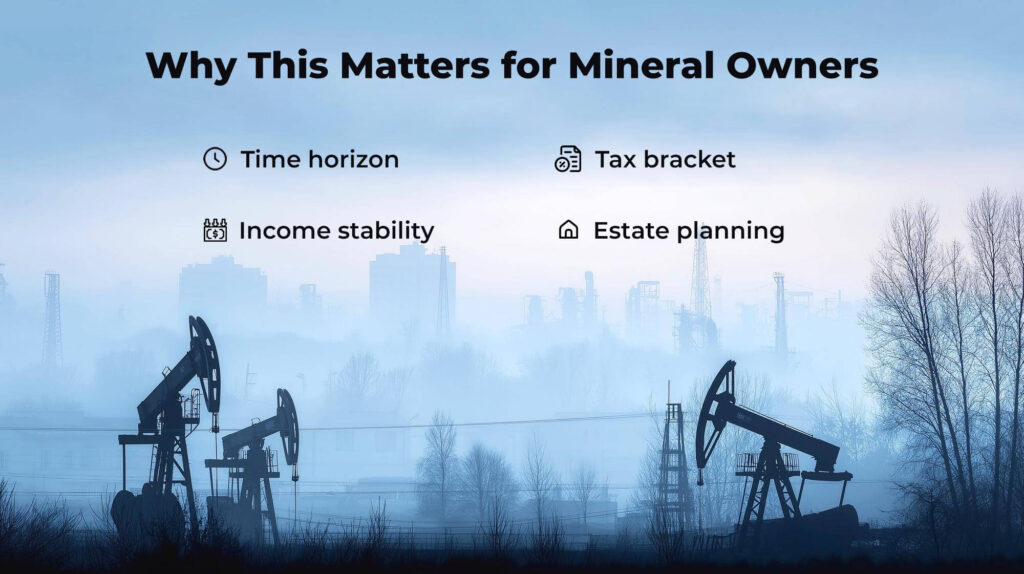Tax Implications of Selling Your Mineral Interest

An important and potentially overlooked aspect of mineral rights ownership, or royalty income, is how these assets are taxed. For many mineral owners, deciding whether to keep collecting royalty income or sell the interest outright involves weighing not just financial and risk factors but also the tax implications. Depending on your tax bracket, selling may offer a more favorable outcome.
In this article, we’ll explore the key tax differences between receiving royalty income and selling your mineral interest before all resources are extracted. We’ll also discuss why divestiture might make sense for some owners, particularly those in higher income tax brackets.
Ordinary Income vs. Capital Gains: Key Distinctions

Let’s start with the two types of income you might receive from mineral ownership:
- Royalty income is taxed as ordinary income. Each time you receive a royalty check, that income is added to your total taxable income and taxed at your marginal tax rate.
- Selling your mineral interest, assuming it qualifies as an investment and not business inventory, is generally taxed at capital gains tax rates. If the asset has been held for over a year, it qualifies for long-term capital gains tax rates.
This distinction matters because of the wide gap between ordinary income tax rates and capital gains tax rates:
- Ordinary income tax rates in the U.S. range from 10% to 37%, depending on your income level.
- Long-term capital gains rates are typically 0%, 15%, or 20%. Even for high earners, this is usually less than the top ordinary income tax rate.
For example, if you’re in the 32% tax bracket and earning royalty income, a third of those earnings could be going to taxes. But if you sell your interest and qualify for a 15% capital gains rate, you might pay significantly less in taxes on the proceeds.
Why This Matters for Mineral Owners

Mineral owners often don’t consider the long-term tax drag of royalty income. Even if your mineral rights produce strong and consistent royalties, the income is taxed every year at ordinary rates. This ongoing taxation can reduce the total value you ultimately receive from your assets.
By contrast, selling your mineral interest for a lump sum could be more tax efficient. You get paid once, pay capital gains tax (typically at a lower rate), and then have the option to reinvest or use the money in a way that aligns with your financial goals.
Of course, every situation is different. Here are a few key factors to consider:
- Time horizon: How long do you plan to keep the mineral interest? Will it produce for 5, 10, or 20 more years?
- Income stability: Royalty income depends on oil and gas prices, production volumes, and operational decisions made by the operator. It can fluctuate dramatically.
- Tax bracket: The higher your current or future income, the more appealing a one-time capital gain might be compared to years of taxable income.
- Estate planning: A sale can simplify your estate and avoid complications around valuation or inheritance disputes.
Hypothetical Example
Let’s say you currently receive $10,000 per year in royalties from your mineral interest. If you’re in the 32% tax bracket, you pay $3,200 in taxes annually, leaving you with $6,800 after tax.
Now imagine you sell that mineral interest for $300,000 and it qualifies for long-term capital gains treatment. If you’re in the 15% capital gains bracket, your tax bill would be $45,000, and you’d keep $255,000 after tax, in one lump sum.
To determine which of these outcomes is more favorable, you would need to create a personal financial model which takes into account (a) the likely depletion of the $10,000 gross royalties over time, (b) the income which could be generated from the lump-sum $255,000 over the same course of time, (c) a personal, risk-adjusted discount rate to apply over time, and (d) any other known, material factors, such as changes to your expected tax rates in the future. This is a more in-depth exercise than we will endeavor to cover in detail in this article — however, after this comparison is completed, it is very often true that divestiture results in a higher expected value than hanging onto royalties. Because selling also provides immediate liquidity and thereby removes risk, divestiture can sometimes be rendered a “no brainer”.
Visual Comparison
Here’s a simplified breakdown of the differences:
| Royalty Income | Selling Mineral Interest | |
| Tax Treatment | Ordinary Income (10–37%) | Capital Gains (0–20%) |
| Income Timing | Ongoing (monthly/quarterly) | One-time payment |
| Risk | Subject to price/production volatility | Locked-in value |
| Tax Rate | Based on total income | Based on gain and holding period |
Final Thoughts
Taxes aren’t the only factor to consider when deciding whether to sell your mineral interests, but they are a big one, and are often misunderstood. For many mineral owners, particularly those in higher tax brackets or approaching retirement, selling could provide not just a better tax outcome but also financial peace of mind.
As with any financial decision, it’s important to weigh the pros and cons carefully. Talk to a CPA or tax advisor familiar with mineral interests, and consider your long-term financial goals.
Interested in exploring a sale? Our team can help you understand your options, value your assets, and guide you through the process, with no pressure and no obligations. Give us a call at (281) 674-7131 or visit our Request An Offer page to get the ball rolling.
Important Disclaimer: Allegiance Oil & Gas does not provide tax, legal, or financial advice. The information provided here is for general education only. Please consult with appropriate tax and legal professionals before making any decisions regarding the sale or retention of your mineral interests.




